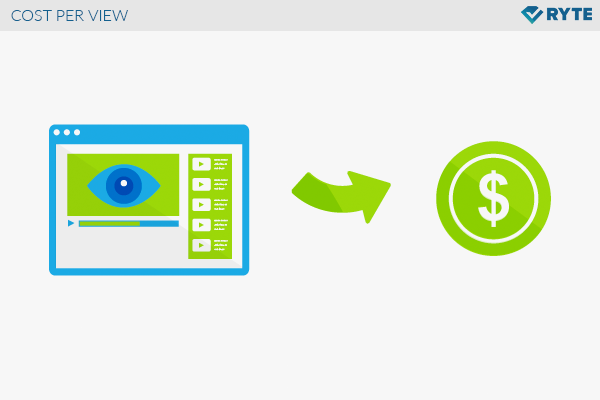Cost Per View
Cost-per-view (CPV) is a relatively recent billing model in Online Marketing, Social Media Marketing, and Video Marketing. The basic idea of the cost-per-view is that the user interacts with the advertising media. A marketer pays for the visual contacts that are generated by requesting an advertising medium on the platform of the publisher.
This principle must be distinguished from impression-based campaigns, since a user’s action, such as a click on Play, Skip, or Expand on a video ad is necessary before the advertiser’s advertising budget is debited. Thus, cost per view is similar to models which are based on the Cost Per Action principle and are part of Performance Marketing.
General information
TubeMogul and Google suggested the cost per view metric at the IAB (Interactive Advertising Bureau), which is responsible for the standardization of digital marketing in the US. This happened at a time when Traffic and usage frequencies of platforms such as YouTube, Vimeo and Facebook continued to rise as a result of video ads. In 2010, the number of daily unique viewers increased by more than 30% according to a study by Comscore.[1]
The problem TubeMogul and Google were trying to address was that the billing models did not further develop even though user behavior and technologies changed rapidly. There were apparently no reliable metrics that enabled the assessment of the performance of campaigns in the context of Video Advertising. As a rule, CPI (Cost per Impression) and the CPM (cost per mille) derived from it were the most frequently used billing models. There is, however, the disadvantage that no distinction can be made between videos which are actually requested by users and those that are not. CPI and CPM also include data where no user interaction has taken place.
If you are billed based on CPM, you won’t know how many users actually clicked the video and you end up paying users who have not clicked. This is a crucial disadvantage for performance-related advertising. These factors make an effective cross-media comparison of different advertising possibilities difficult since only impressions are counted, but the actual advertising effect is difficult to detect. Whether and how long users viewed a video is not clear from the data. CPV was introduced into the discussion in order to make the user interaction and the user engagement scalable with commercial media such as video ads.
How the CPV is calculated
The cost per view value can be calculated like other metrics, but in most cases it is specified by the publisher. Common values are between 0.10 and 1.00 Euro per video, which is often calculated by publishers depending on the duration of the playback. Marketers need to review how much playback of an advertising video is worth to them and use these metrics to decide whether cost per view meets their campaign requirements. The CPV is calculated by dividing the total advertising costs by the number of views.
CPV = costs / views
How it works
The difference of cost per view to other billing models is the user intention:[2] If users are willing to consume an advertisement, the level of acceptance is high and the risk of Banner Blindness low. It is assumed that user-initiated advertising content are more likely to transport the brand messages. However, they can be differentiated from other methods such as pre-roll and auto-inserts, especially when the performance of a campaign is in the foreground.
CPV values allow a deeper insight into user engagement and are therefore valuable data for marketers and publishers. This data also increases the transparency of the billing model and simplifies budgeting. After all, marketers pay only the video ads, which have actually been initiated by the users. However, there are also limitations. Aspects such as brand awareness and viral videos cannot be represented with CPV.[3] The long-term effects of branding campaigns cannot be assessed with CPV. Moreover, a user can view a viral video without being interested in a particular brand. Formats that go beyond click-through user interaction are difficult to scale with the cost per view metric.
Whether marketers opt for the CPV depends on several factors. Online advertising campaigns can only be tested for their effectiveness with regard to pre-defined objectives. In such cases, values such as CPI, CPM, or cost per hour suggested by Financial Times may be more appropriate.
Relevance to online marketing
Cost per view has played an important role in the marketing of video content for several years now. The required user interaction incorporates a certain amount of user engagement into the calculations. The resulting transparency in capturing and evaluating advertising metrics allows marketers to have precise budgeting. The budget gets defined and you immediately know how many clicks it represents. Companies such as Google, YouTube, and Facebook offer cost per view as an optional billing model. CPV values can also partially be bid on if the model is connected to the provider’s Real-Time Bidding. As a rule, publishers also provide their customers with additional information and recommendations on possible billing models, allowing marketers to choose a model that matches the campaign goals.
References
- ↑ Cost-Per-View Pricing for Digital Video: What Would It Really Measure? mediapost.com. Accessed on 09/11/2015
- ↑ Cost Per View: Will Viewer Choice Mean More Engaged Consumers? blogs.imediaconnection.com. Accessed on 09/11/2015
- ↑ Why Video Advertising Needs to Dump Impressions and Move to 'Cost Per View' adage.com. Accessed on 09/11/2015

